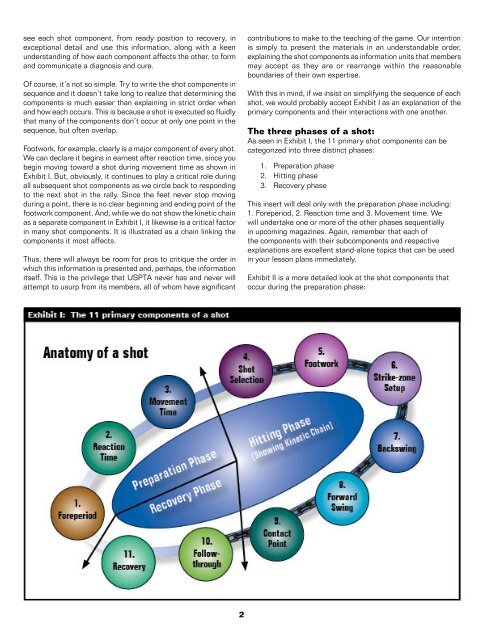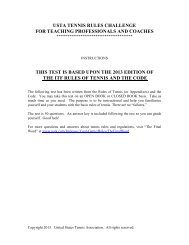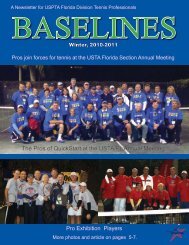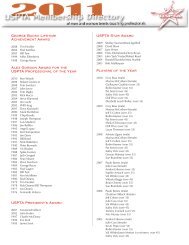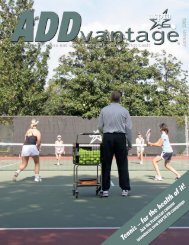Volume 2, No. 3 - United States Professional Tennis Association
Volume 2, No. 3 - United States Professional Tennis Association
Volume 2, No. 3 - United States Professional Tennis Association
Create successful ePaper yourself
Turn your PDF publications into a flip-book with our unique Google optimized e-Paper software.
see each shot component, from ready position to recovery, in<br />
exceptional detail and use this information, along with a keen<br />
understanding of how each component affects the other, to form<br />
and communicate a diagnosis and cure.<br />
Of course, it’s not so simple. Try to write the shot components in<br />
sequence and it doesn’t take long to realize that determining the<br />
components is much easier than explaining in strict order when<br />
and how each occurs. This is because a shot is executed so fluidly<br />
that many of the components don’t occur at only one point in the<br />
sequence, but often overlap.<br />
Footwork, for example, clearly is a major component of every shot.<br />
We can declare it begins in earnest after reaction time, since you<br />
begin moving toward a shot during movement time as shown in<br />
Exhibit I. But, obviously, it continues to play a critical role during<br />
all subsequent shot components as we circle back to responding<br />
to the next shot in the rally. Since the feet never stop moving<br />
during a point, there is no clear beginning and ending point of the<br />
footwork component. And, while we do not show the kinetic chain<br />
as a separate component in Exhibit I, it likewise is a critical factor<br />
in many shot components. It is illustrated as a chain linking the<br />
components it most affects.<br />
Thus, there will always be room for pros to critique the order in<br />
which this information is presented and, perhaps, the information<br />
itself. This is the privilege that USPTA never has and never will<br />
attempt to usurp from its members, all of whom have significant<br />
contributions to make to the teaching of the game. Our intention<br />
is simply to present the materials in an understandable order,<br />
explaining the shot components as information units that members<br />
may accept as they are or rearrange within the reasonable<br />
boundaries of their own expertise.<br />
With this in mind, if we insist on simplifying the sequence of each<br />
shot, we would probably accept Exhibit I as an explanation of the<br />
primary components and their interactions with one another.<br />
The three phases of a shot:<br />
As seen in Exhibit I, the 11 primary shot components can be<br />
categorized into three distinct phases:<br />
1. Preparation phase<br />
2. Hitting phase<br />
3. Recovery phase<br />
This insert will deal only with the preparation phase including:<br />
1. Foreperiod, 2. Reaction time and 3. Movement time. We<br />
will undertake one or more of the other phases sequentially<br />
in upcoming magazines. Again, remember that each of<br />
the components with their subcomponents and respective<br />
explanations are excellent stand-alone topics that can be used<br />
in your lesson plans immediately.<br />
Exhibit II is a more detailed look at the shot components that<br />
occur during the preparation phase:<br />
2


